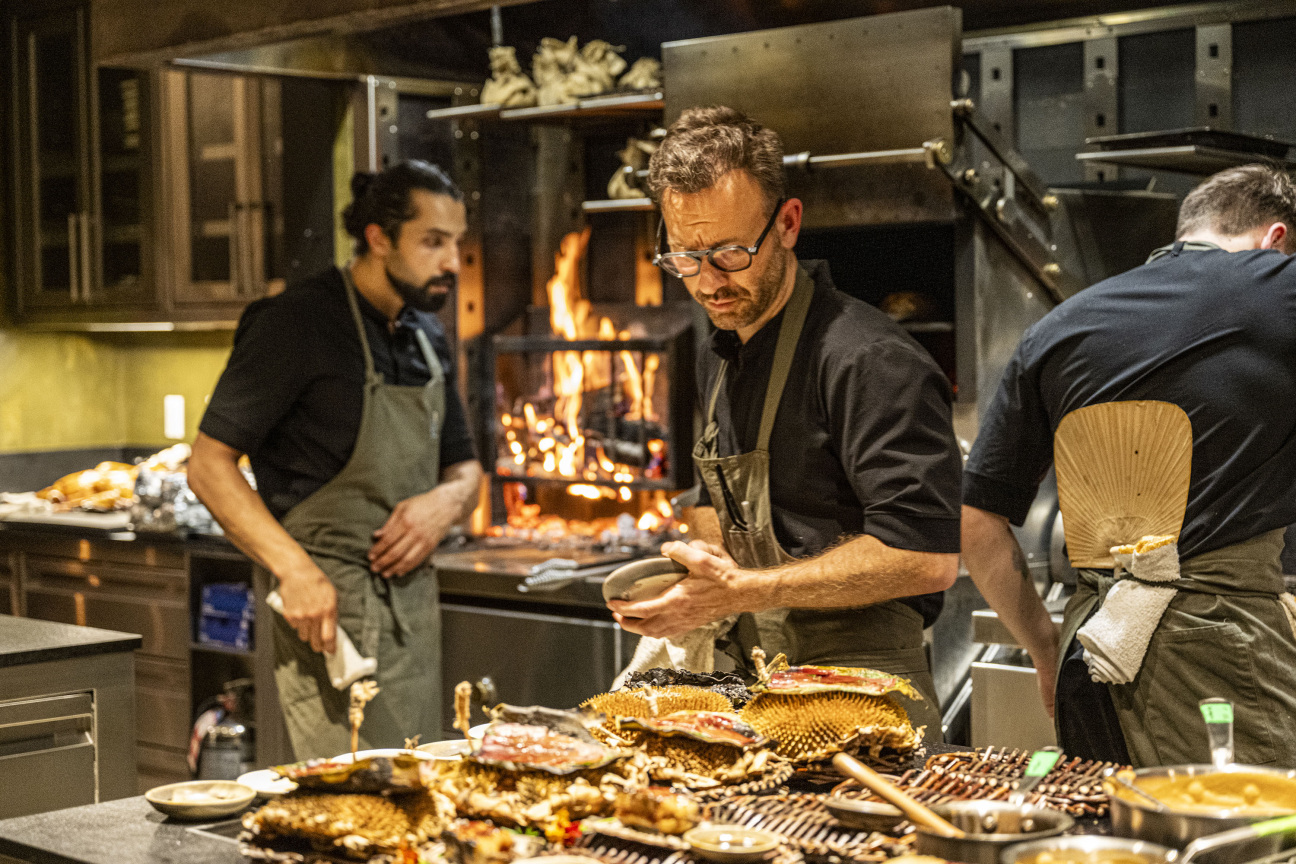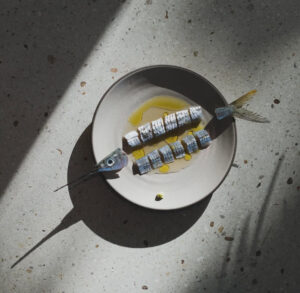
Ilis, the new Brooklyn restaurant from Mads Refslund, the co-founder of Copenhagen’s legendary Noma, has been one of the hottest tables in town since it opened last fall. If diners can manage to get a reservation there, they have the option to choose between hot and cold. The restaurant’s name, Ilis, is a portmanteau of the Danish words for fire and ice, and each diner is asked to select which way they want their selection of seasonal produce, meat, and fish prepared.
The choose-your-own-adventure twist on a tasting menu is the latest boundary-blurring endeavor from Refslund, who also founded Michelin-starred restaurant MR and Acme in New York. After departing Acme and traveling through Mexico and Japan, Refslund returned to the Big Apple in October with his business partner Will Douillet—and he plans to stay for the long haul. Six months into his latest venture, Refslund lets CULTURED in on his culinary origin story, his go-to New York watering holes, and how he makes a favorite Ilis dish with a single carrot.
Tell us about the food environment you grew up in.
My mom and dad got divorced when I was young and my dad was working nights at a newspaper; he slept most of the day. It was a lot of frozen pizzas. What I remember most was from my grandmom. She was very old school, did everything by herself: patés, soups and stews, jams and vinegars, all these things that were going through generations. That's where I saw a little bit of the history behind Danish cuisine.
My mom was more like, “We don't need to follow recipes—just put things together you like.” At that time, I didn't understand it. I always thought the food would taste really bad. But the way I'm cooking now is based on that way of putting things together.

How did you know you wanted to become a chef?
In Denmark, in 8th, 9th, and 10th grade, you do an internship where you think about what you want to become. My teacher at that time thought it would be a good idea if I tried becoming a chef because I couldn't sit still. I went to a fine dining restaurant, and it just blew me away immediately—the smell in the kitchen, the energy, the creative aspect.
Were there lessons that you took with you from opening Noma and Acme as you opened Ilis? What did you want to do differently or repeat?
I came from a high-end dining scene in Copenhagen. I was involved with Noma, but I also had another restaurant called MR for six years, [which also had a] Michelin star. I was only working in high-end environments and then I came to New York and I’m doing a place like Acme—I had never done à la carte in my life. It was not in my vocabulary. But that was what Acme was about. And I very quickly learned how to do 250 covers with the same amount of [staff] I had at MR, where there were 28 guests with eight cooks in the kitchen.
When I created Ilis it was more about mixing these two worlds of creating a dining scene where you have choices, but it's also controlled. I feel that we are nailing that because at Ilis, it’s not a set menu and it's not à la carte—it's a mix. It's an ingredient-driven restaurant where we are presenting seasonal ingredients in front of you—like you go into the market, you see the ingredients, you choose, and then we cook it for you. We have two ways of cooking: fire and ice. That's what [the word] Ilis means—it’s a combination of two words, fire and ice, in Danish.
You pick the ingredients you like—a minimum of five or up to 12—and then we create that menu for you. You also have the freedom of choosing if you want it grilled or cold.
What is your process of creating new dishes like?
I've been working with this cuisine for a long time. It’s how I like to cook, and my brain is constantly in a creative mood. I come to the market every week and I meet every morning with my research and development chef. He collects all the things, and then I have one to two days with him in the kitchen where I put them together in a way I like. And then besides that, I'm just in service.

Your restaurant has a “one-house” structure as opposed to a distinct front and back of house. I wondered how you feel that affects the experience of both guests and staff?
We created this one-house concept because of the New York tip system, where waiters and cooks are so divided. Waiters are earning so much more money than cooks, and I didn't think it was fair. I'm coming from a world where we were sharing it down in the middle, but you cannot do that in the United States. So I thought, Why not? We’ll just break down the house and you have two weeks in the kitchen, two weeks in the dining room, and you're getting a mix of both worlds.
For the guest experience, it's been something we struggle with—[our staff members] are not waiters, they are cooks. Who knows more about food than the person who's cooking it? Maybe they're not as good at explaining the food, maybe they don't know exactly how to pull the chair out for the guest properly—I know that service at Ilis is maybe not as high-end as the best restaurants in the world. But it's a learning process. I know that it's honest and pure, and I know everyone working at Ilis right now is happy.
What made you feel ready to settle down with Ilis and be in one place for a while?
Oh, I'm here for good. I'm putting 100 percent of my soul into this. I've been looking for a place for eight years. We were lucky—the landlord came to us and asked me if I wanted to open this place. And I was like, Greenpoint? I don't know anything about Greenpoint. I was very skeptical, but I fell in love with the neighborhood.
It’s true I've been kind of a nomad for many years, so you can see when you go to the restaurant that it's very inspired by New York, but also by my travels in Mexico, Japan, and Denmark.
On that note, is there a dish that you feel really like represents where you're at in life right now?
Oh, there are so many dishes that represent us right now. But I can tell you one thing for sure—in a couple of months, they will not be on the menu. Right now, it's 15 percent root vegetables and then five to 10 percent fermentation. Then the rest is seafood and a little bit of meat. I like the grilled eel we’ve had since we opened. For a while, the sauce was made out of roses. Now, we're serving [it with] leek roots that guests use as a brush to put the leek sauce on. But the eel is still the same.

What do you think is an overrated ingredient right now? What about an underrated ingredient?
We are using a lot of caviar right now, but I think caviar is a little bit overrated. We also have a very simple dish right now—it's just a carrot. We take the peel, dry it, and blend it with oil, so we get this carrot oil that's deep red. Then we take the carrot and we cut it into three sections. We take the top bits and make that into a pesto with a little bit of salt. Then we take the thick part of the carrot and steam that and puree it. We take the thin part and juice it, mix these two together, and add a little bit of salt, and it's a soup. We put the pesto in and that's it.
I really enjoy that dish—it's just a carrot, but it's not just a carrot, it's actually much more. It's the sense of being pure and leaving it almost untouched.
Is there a kitchen rule that you live by at home and at work?
Keep it clean. But I can tell you that being creative is messy.
What do you like to cook for yourself at home?
Soups right now, salads in the summer. When I'm home, I eat mostly vegetables.
Do you have a go-to bodega order?
No… but one of the best places to eat at the moment is Achilles Heel in Greenpoint. It is kind of a bar, but it's amazing food. I like a glass of orange wine, and the best place to go for natural wine and good food is The Four Horsemen [in Greenpoint]. If you want a good cocktail, Maison Premiere [in Williamsburg]. Everything is in Brooklyn right now.










 in your life?
in your life?

